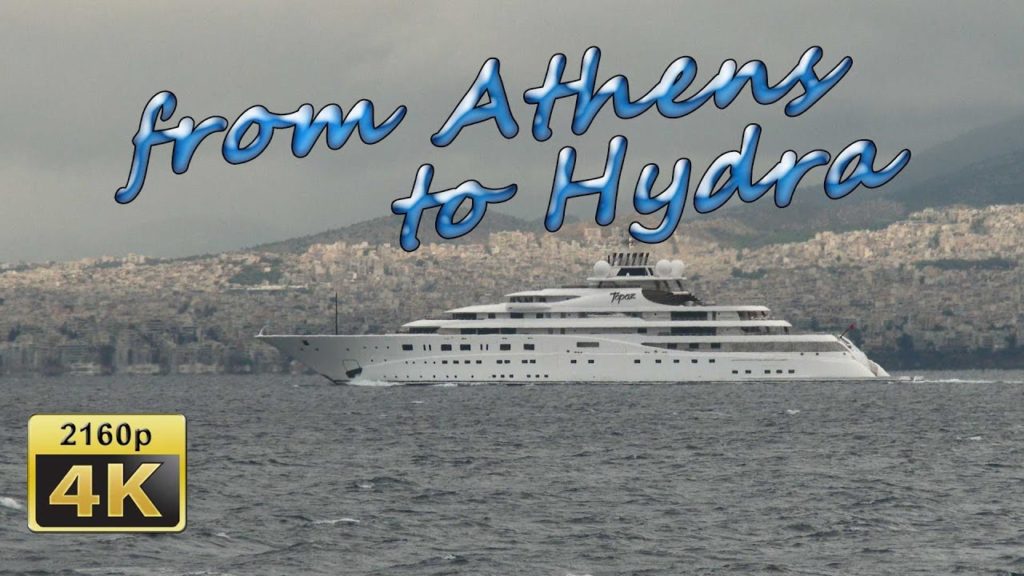In Athens, we have the opportunity to participate in a one-day trip to the islands of Hydra, Poros and Aegina. From the Acropolis Metro station we go by bus to the Trocadero Marina in the suburb Paleo Faliro. Paleo Faliro was the ancient port of Athens which lost its importance after the construction of a port in Piraeus. When getting out of the bus, our eyes first turned to a Greek trireme and we were afraid that we have to row to Hydra. But of course this wasn’t the case. We were accompanied to a modern catamaran, the Platytera, lying just next to it. From the upper deck of the catamaran we have a good general view over the Athens’s ship museum
Besides the reconstruction of an Athenian trireme of the 5th century with 3 rows of oars above each other, the armored cruiser Georgios Averof and the destroyer Velos are the highlights of this museum. The Georgios Averof enjoys a national myth because it causes heavy losses to the Ottoman Empire, without getting seriously damaged.
When leaving the port we can take again a calm look at all ships.
The weather is changeable and not inviting to take a sunbath. The lovely light and play of colour compensated us for everything. Sunbeams break through the dark cloud cover again and again and set color accents in the landscape.
The view from sea goes across over Athens with the Olympic stadiums. The Peace- and Friendship Stadium, the football stadium and the two smaller stadiums for basketball and handball, dominate the cityscape.
We pass Aegina and Poros on our right and approach the Peloponnese.
The friendly Kaptän Nikos Kokonas allowed us to visit the bridge. We have the opportunity to take a closer look at the navigation instruments. The captain calls his German employee, Mrs Britta Seemann, who kindly translated.
2 days ago the waves were 4 m high, but the Platytera, a catamaran for 450 passengers with a length of 57 m could sail without problems. Then he explains us the further itinerary.
……
please read more:
In Athen haben wir die Gelegenheit an einer eintägigen Bootstour zu den Inseln Hydra, Poros und Ägina teilzunehmen.
Mit dem Bus geht es von der Acropolis Metro Station zur Trokadero Marina im Vorort Paleo Faliro. Paleo Faliro war der antike Hafen Athens, der aber nach dem Bau eines Hafens in Piräus seine Bedeutung verlor. Beim Aussteigen fällt unser erster Blick auf eine griechische Triere und wir haben schon die Befürchtung nach Hydra rudern zu müssen. Doch dem war natürlich nicht so. Wir wurden auf einen modernen Katamaran, die Platytera geleitet, die daneben lag. Hier bot sich uns ein guter Überblick über das Schiffsmuseum von Athen.
Neben dem Nachbau einer attischen Triere aus dem 5. Jahrhundert, mit 3 Ruderreihen übereinander sind der Panzerkreuzer Georgios Averoff und der Zerstörer Velos die Highlights dieses Museums. Die Georgios Averoff genießt einen nationalen Mythos, da sie dem Osmanischen Reich schwere Verluste beibrachte, ohne selbst ernsthaft beschädigt zu werden.
Beim Auslaufen aus dem Hafen können wir alle Schiffe nochmals in Ruhe begutachten.
Das Wetter ist wechselhaft und lädt nicht gerade zum Sonnenbaden ein, aber dafür entschädigt uns die Natur mit einem wunderschönen Licht- und Farbenspiel. Immer wieder durchbrechen Sonnenstrahlen die dunkle Wolkendecke und setzen farbliche Akzente in der Landschaft.
Von See aus erstreckt sich der Blick über Athen, wobei die olympischen Stadien, das Peace- and Friendship Stadium, das Fußballstadium und die beiden kleineren Stadien, das Basketball und das Handballstadion, das Stadtbild beherrschen.
Wir lassen Ägina und Poros rechts liegen und nähern uns dem Peloponnes.
Der freundliche Kaptän Nikos Kokonas lässt uns zu sich auf die Brücke und wir haben die Gelegenheit die Navigationsgeräte in Augenschein zu nehmen. Der Kapitän ruft seine deutsche Mitarbeiterin, Frau Britta Seemann, die uns dankenswerterweise übersetzt. Er erzählt, dass vor 2 Tagen 4 m hohe Wellen waren, doch das Schiff, die Platytera, ein Katamaran für 450 Passagiere mit einer Länge von 57 m, konnte ohne Probleme fahren. Er erläutert uns auch die weitere Fahrtroute.
……
Weitere Infos im Reisevideoblog:


AloJapan.com